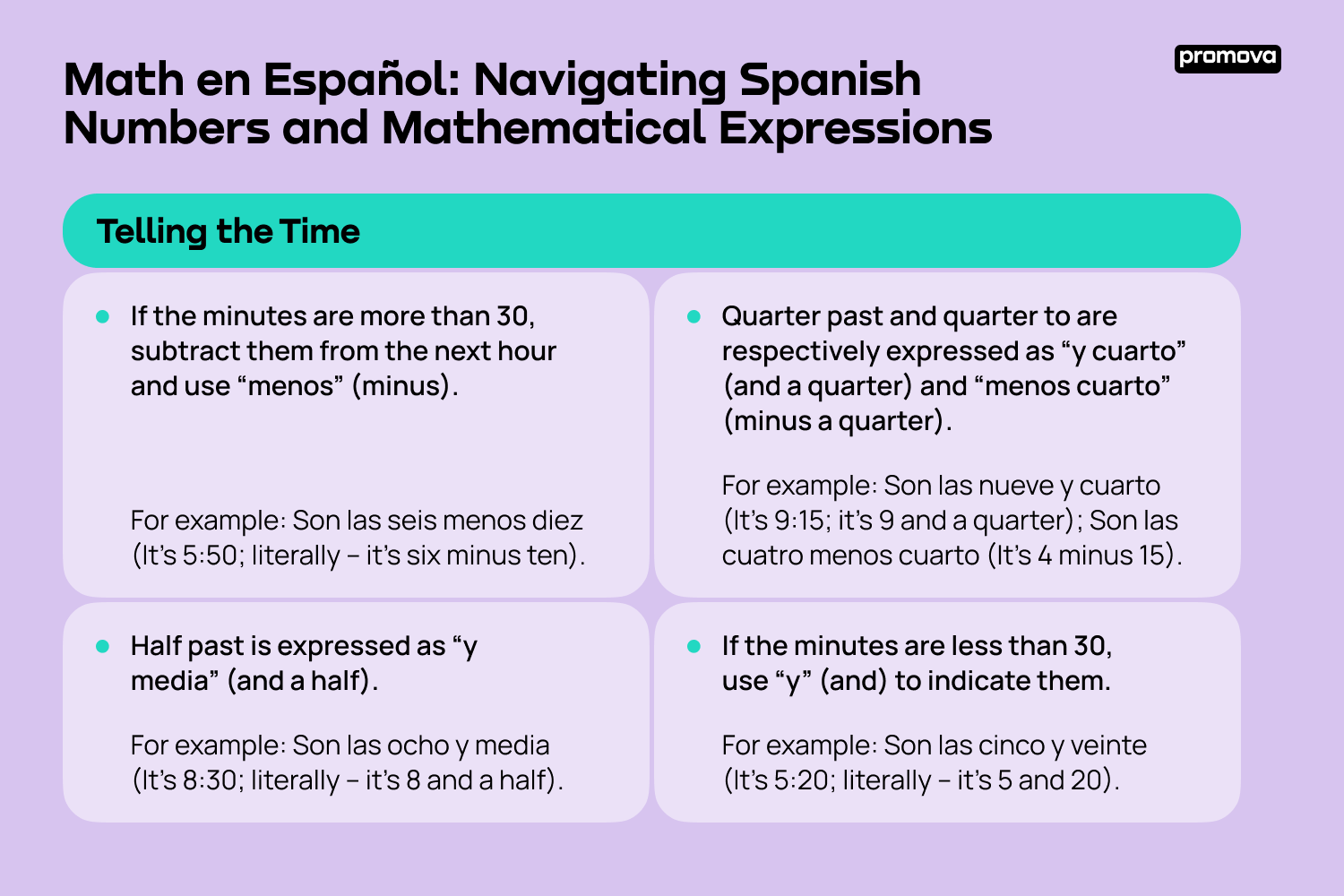Math en Español: Navigating Spanish Numbers and Mathematical Expressions

Contents
If you believe learning to count in a foreign language is optional, let us prove you wrong. Of course, we don’t say you should become the next Alan Turing (only if you want to). But from the moment we learn to count as children, numbers become an integral part of our lives. Whether shopping in Madrid, exploring flea markets in Barcelona, or buying coffee in Mexico, it is essential to know all the numerals. Today, we will tell you everything you need about the numbers in Spanish. So, without further ado, let’s dive into this article!
The Basics: Cardinal Numbers in Spanish
Cardinal numbers are the foundation of any numeric system, serving as the fundamental building blocks for counting and quantifying. In Spanish, these numbers are essential for everyday communication, whether you’re discussing quantities, giving your age, expressing time, or simply ordering a meal at a restaurant. For starters, let’s learn how to count in Spanish from one to ten:
- Uno – one.
- Dos – two.
- Tres – three.
- Cuatro – four.
- Cinco – five.
- Seis – six.
- Siete – seven.
- Ocho – eight.
- Nueve – nine.
- Diez – ten.
These numbers are relatively straightforward and will likely be among the first you learn when studying Spanish. They provide the foundation upon which larger numbers are constructed.
Building Blocks Using Spanish Numbers: From 10 to 100 and Beyond
Counting from 10 to 100 in Spanish involves a combination of cardinal numbers and a consistent pattern that makes it relatively straightforward. Let’s delve into the details of this numerical journey step by step.
The Spanish numbers follow a unique pattern from 11 to 19. Here’s how they are constructed:
- 11 - Once – eleven.
- 12 - Doce – twelve.
- 13 - Trece – thirteen.
- 14 - Catorce – fourteen.
- 15 - Quince – fifteen.
- 16 - Dieciséis – sixteen.
- 17 - Diecisiete – seventeen.
- 18 - Dieciocho – eighteen.
- 19 - Diecinueve – nineteen.
From 20 onwards, the pattern becomes more regular and mirrors the English counting system. The formula is simple: take the tens place (e.g., “veinte” for 20), then add the units place (e.g., “uno” for 1, “dos” for 2, etc.). Here’s how it works:
- 20 - Veinte – twenty.
- 21 - Veintiuno (20 + 1) – twenty-one.
- 22 - Veintidós (20 + 2) – twenty-two.
- 23 - Veintitrés (20 + 3) – twenty-three.
- 24 - Veinticuatro (20 + 4) – twenty-four.
- 25 - Veinticinco (20 + 5) – twenty-five.
- 26 - Veintiséis (20 + 6) – twenty-six.
- 27 - Veintisiete (20 + 7) – twenty-seven.
- 28 - Veintiocho (20 + 8) – twenty-eight.
- 29 - Veintinueve (20 + 9) – twenty-nine.
This pattern continues consistently up to 99, with the tens place followed by the units place:
- 30. Treinta – thrity.
- 40. Cuarenta – forty.
- 50. Cincuenta – fifty.
- 60. Sesenta – sixty.
- 70. Setenta – seventy.
- 80. Ochenta – eighty.
- 90. Noventa – ninety.
To count in hundreds, Spanish introduces the term “cien” for 100. However, when counting from 101 to 199, “ciento” is used instead of “cien”:
- 100. Cien – one hundred.
- 101. Ciento uno – one hundred and one.
- 102. Ciento dos – one hundred and two.
- 110. Ciento diez – one hundred and ten.
Now that you know numbers in Spanish 1-100, it is time to move even further. For example, the term “mil” is used for a thousand, and creating higher numbers follows a similar pattern. Take a look at this list.
- 1,000. Mil – one thousand.
- 2,000. Dos mil – two thousand.
- 3,000. Tres mil – three thousand.
- 10,000. Diez mil – ten thousand.

Mathematical Expressions in Spanish
Counting to 100 in Spanish goes alongside other important expressions and terms. Of course, we won’t give you a complete overview of a math book. Yet, we’ll share some of the most common words that express basic arithmetic operations.
- Addition.
“Más” is the Spanish word for “plus,” and “sumar” is the verb for “to add.” For instance, “two plus thre” would be “dos más tres” in Spanish.
- Subtraction.
“Menos” corresponds to “minus,” and “restar” means “to subtract.” To express “five minus two,” you would say “cinco menos dos.”
- Multiplication.
“Por” translates to “times” or “multiplied by,” and “multiplicar” signifies “to multiply.” For example, “four times six” would be “cuatro por seis.”
- Division.
“Entre” stands for “divided by,” and “dividir” denotes “to divide.” “ten divided by two” would be “diez entre dos.”
Telling the Time
Another great reason to memorize the list of numbers in Spanish is to freely ask and tell time whenever it is needed. This process is fairly straightforward in this language. Here’s the basic structure:
- If the minutes are less than 30, use “y” (and) to indicate them.
For example: Son las cinco y veinte (It’s 5:20; literally – it’s 5 and 20).
- If the minutes are more than 30, subtract them from the next hour and use “menos” (minus).
For example: Son las seis menos diez (It’s 5:50; literally – it’s six minus ten).
- Half past is expressed as “y media” (and a half).
For example: Son las ocho y media (It’s 8:30; literally – it’s 8 and a half).
- Quarter past and quarter to are respectively expressed as “y cuarto” (and a quarter) and “menos cuarto” (minus a quarter).
For example: Son las nueve y cuarto (It’s 9:15; it’s 9 and a quarter); Son las cuatro menos cuarto (It’s 4 minus 15).

Ranking and Ordering: Ordinal Spanish Number List
Ordinal numbers hold the key to ranking and organizing elements in any language. In Spanish, they are essential for categorizing items, expressing sequence, and indicating position. Let’s dive into this realm of ranking and ordering, exploring the intricacies of ordinal numbers and their diverse applications.
Ordinal numbers in Spanish typically end in “-o” for masculine and “-a” for feminine. Here are the first ten ordinal numbers:
- Primero (masculine) / Primera (feminine) – first.
- Segundo (masculine) / Segunda (feminine) – second.
- Tercero (masculine) / Tercera (feminine) – third.
- Cuarto (masculine) / Cuarta (feminine) – fourth.
- Quinto (masculine) / Quinta (feminine) – fifth.
- Sexto (masculine) / Sexta (feminine) – sixth.
- Séptimo (masculine) / Séptima (feminine) – seventh.
- Octavo (masculine) / Octava (feminine) – eighth.
- Noveno (masculine) / Novena (feminine) – ninth.
- Décimo (masculine) / Décima (feminine) – tenth.
After the 10th ordinal number, the pattern continues with the same structure:
- Undécimo (masculine) / Undécima (feminine) – eleventh.
- Duodécimo (masculine) / Duodécima (feminine) – twelfth.
- Decimotercero (masculine) / Decimotercera (feminine) – thirteenth.
- Vigésimo (masculine) / Vigésima (feminine) – twenties.
- Vigésimo primero (masculine) / Vigésima primera (feminine) – twenty-first.
- Trigésimo (masculine) / Trigésima (feminine) – thirtieth.
- Centésimo (masculine) / Centésima (feminine) – one hundredth.
Ordinal numbers agree in gender and number with the noun they modify. For example, “el primer día” (the first day) and “la primera semana” (the first week). Numbers 21 and above can be expressed as a compound of “vigésimo” and the regular ordinal number. For instance, “vigésimo quinto” for 25th.
Bonus! Famous Spanish Number Idioms
The best way to consolidate acquired knowledge is to use it in practice. And idioms are a perfect way to memorize different Spanish numbers and get acquainted with colloquial expressions and phrases. Therefore, we’ve created a list of famous Spanish sayings that contain different numbers.
- Ser un cero a la izquierda – to be a zero on the left. This idiom is used to describe someone who is insignificant, irrelevant, or unimportant in a certain context (like the 0 on the left of any number – it doesn’t change anything). For example:
No le presté atención en la reunión, siempre es un cero a la izquierda.
I didn’t pay attention to him in the meeting, he’s always insignificant.
- Ser más chulo que un ocho – to be cooler than an eight. This idiom means to be conceited or arrogant, often excessively so. Its literal meaning is “cooler than the eight.” For example:
Desde que ganó el premio, está más chulo que un ocho.
Since he won the prize, he’s as conceited as can be.
- Ser cuatro gatos – to be four cats. This phrase is used to describe a small number of people or things. It’s similar to saying “there aren’t many of us” in English. For example:
No había nadie en la conferencia, éramos cuatro gatos.
There was no one at the conference, there were just a few of us.
- Buscarle tres pies al gato – to look for three feet in a cat. As you can see, Spanish people really like cats. This idiom means to overcomplicate things or to look for unnecessary problems or faults. For example:
Siempre intenta buscarle tres pies al gato en lugar de simplemente hacerlo.
He always tries to overcomplicate things instead of just getting them done.
- Cada dos por tres – every two by three. This saying means something happens frequently or repeatedly, often without much time in between. For example:
Cada dos por tres me llama para pedir ayuda.
He calls me for help every now and then.
- Estar en el quinto pino – to be in the fifth pine tree. This idiom means to be in a very remote or distant location. For example:
La casa de Juan está en el quinto pino, casi nunca voy allá.
Juan’s house is in a really remote place, I hardly ever go there.
14
Enhance Learning and Memorize Spanish Numbers 1-100 with Promova
Using a mobile app to enhance your Spanish language skills can be a highly effective and convenient way to learn, practice, and improve your proficiency. The accessibility and flexibility make it an excellent tool for language learners of all levels. Whether you are looking for an extensive Spanish number chart or interactive lessons to boost your memory, Promova has got you covered. But that’s not all! Here’s what else you can access:
- Convenience and Accessibility. The Promova app brings language learning to your fingertips. This accessibility enables you to engage with the language consistently, fitting language learning into your daily routine.
- Personalized Learning. We offer personalized learning experiences. Our application adapts to your skill level, learning pace, and goals. Through assessments and an initial questionnaire, we determine your proficiency and design lessons that cater to your specific needs. This tailored approach ensures efficient learning and prevents boredom or frustration.
- Bite-sized Lessons. All content in the Promova app is presented in bite-sized chunks. This approach is conducive to learning, as it prevents information overload and allows you to focus on mastering small portions of the language at a time. These manageable lessons are ideal for busy schedules and make it easier to track your progress.
- Interactive Activities. Promova uses a variety of interactive activities created by experienced Spanish tutors to engage learners. These activities include quizzes, games, listening exercises, and speaking challenges. The interactive nature of these features keeps learning engaging, fun, and effective.
- Vocabulary Building. We provide a structured way to expand your Spanish vocabulary. Promova introduces new words and phrases in context, allowing you to understand their usage and meaning. Vocabulary-building exercises, flashcards, and spaced repetition techniques help reinforce your memory and retention of words.
- Grammar Practice. Grammar is a fundamental aspect of language learning. Our app offers grammar lessons and exercises that help you understand Spanish grammar rules and structures. Interactive exercises and quizzes ensure that you grasp the concepts thoroughly.
- Progress Tracking. We have many tools that allow you to monitor your advancement, track completed lessons, and see how much you’ve learned over time. Monitoring your progress can be highly motivating and satisfying.
In conclusion, using the Promova app to enhance your Spanish level offers a dynamic, flexible, and engaging approach to language learning. It combines convenience with effective learning techniques, enabling you to progress at your own pace and build a strong foundation in the language. Whether you’re a beginner or aiming to improve advanced skills, incorporating a language learning app into your routine can contribute significantly to your Spanish language journey.
Conclusion
In conclusion, our exploration of numbers in Spanish has not only equipped us with the ability to count and calculate but has also deepened our understanding of language structure, cultural idioms, and practical communication.
Through this journey, we’ve discovered that numbers are not merely mathematical entities but powerful linguistic tools that connect us with Spanish speakers around the world. So, whether you’re ordering coffee in a bustling café, telling time in a foreign city, or engaging in a mathematical discussion, your newfound understanding of Spanish numbers will undoubtedly enhance your linguistic experience.
FAQ
How do I express fractions and decimals in Spanish?
Fractions in Spanish are expressed using the word “fracción.” To convey a fraction, you use the numerator (the top number), and then the denominator (the bottom number). For example: 1/2 = uno medio (one-half); 3/4 = tres cuartos (three-fourths), etc. Decimal numbers in Spanish are separated by a comma, not a period. For example: 3,14 = tres coma catorce (three point fourteen); 0,5 = cero coma cinco (zero point five), etc.
How do I express a range of numbers in Spanish, like “from 10 to 20”?
To express a range, use “de” to connect the two numbers. For instance, “de diez a veinte” means “from ten to twenty.” Remember that the ending of the last number in the range should agree in gender and number with the noun it modifies.
Are there any cultural taboos or superstitions related to numbers in Spanish-speaking countries?
Yes, like in any other country, Spanish-speaking people have their superstitions related to different numbers. For example, similar to other parts of the globe, some Spanish-speaking people consider the number 13 unlucky. But number 15 in Spain, instead, is a symbol of good luck and fortune.
What are some strategies for remembering the pronunciation of Spanish numbers?
Start by learning the numbers from 1 to 20, as they are the building blocks. Gradually expand your knowledge to include tens, hundreds, and beyond. Practice regularly, engage with native speakers, and reinforce your learning with interactive resources.
Comments